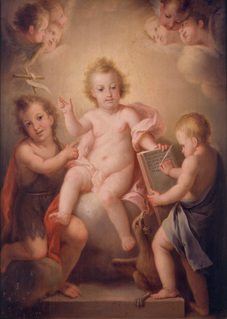The Great O Antiphons
How delightful to see in this painting both little Johns, the Baptist and the Theologian, together  with the Incarnate Word, Holy Wisdom. Note that the little Evangelist is already writing the opening words of the Prologue of his Gospel.
with the Incarnate Word, Holy Wisdom. Note that the little Evangelist is already writing the opening words of the Prologue of his Gospel.
Reflections on each of the Great O Antiphons are available in my Advent archives from 2006. At the Monastery of the Glorious Cross where I serve as chaplain, the Great O’s are sung not only at Vespers each day, their traditional place, but also during the Gospel procession of the Mass as the Alleluia Verse.
We know that in the reform of the Lectionary, the O Antiphons, formerly sung only at Vespers, were also given a place within the Mass itself, becoming the verse of the Alleluia before the Gospel. The General Instruction on the Roman Missal emphasizes the importance of the procession with the Book of the Gospels. It is a kind of parousia, the glorious appearing of the Lord “amid cries of gladness and thanksgiving, the throng wild with joy” (Ps 41:5). It is the arrival of the Bridegroom; His advent is greeted with jubilant alleluias and with lighted lamps. It is the descent of the all-powerful Word from the royal throne “into the midst of the land that was doomed” (Wis 18:15). The Gregorian Alleluia, with its streaming jubilus, is the Church’s ecstatic cry of welcome; it is an eschatological song. The arrival of Christ in the sacramental Word anticipates His arrival in glory upon the clouds of heaven (cf., Mt 24:30).
This year I am not preaching specifically on the Great O Antiphons as I have done in past years, but readers of Vultus Christi might find last year’s homilies helpful.
